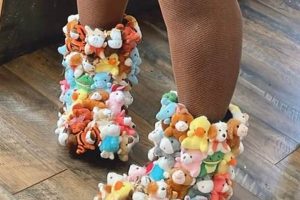Using plush toys, particularly those resembling bears, as manipulative objects for early childhood numeracy activities provides a tangible and engaging introduction to mathematical concepts. For example, a child might be asked to count out three bears or add two bears to an existing group. This approach leverages the familiarity and comfort children often associate with these toys to create a positive learning experience.
This playful pedagogical approach offers several benefits. It facilitates the development of one-to-one correspondence, a fundamental skill in understanding number values. It also supports the acquisition of early addition and subtraction skills, fostering a concrete understanding of these abstract operations. Historically, commonplace objects have been utilized in early education to ground abstract concepts in tangible reality. Plush toys, with their inherent appeal to young children, represent a contemporary application of this principle.
Further exploration will delve into specific applications of this method, including variations based on age group, learning objectives, and integration with other educational activities. Practical examples and case studies will be provided to illustrate its efficacy in promoting mathematical understanding in young learners.
Tips for Utilizing Plush Toys in Early Numeracy Development
The following tips offer guidance on effectively incorporating plush toys into activities designed to enhance early numeracy skills.
Tip 1: Start with Concrete Counting: Begin by having learners count individual toys, establishing a solid understanding of one-to-one correspondence. For instance, have them touch each toy while reciting the corresponding number.
Tip 2: Introduce Simple Addition and Subtraction: Once comfortable with counting, introduce basic addition and subtraction problems using the toys. “If we have three bears and add one more, how many do we have?”
Tip 3: Incorporate Storytelling: Weave narratives into the activities to increase engagement and contextualize the mathematical operations. A story about bears going on a picnic can be used to practice adding and subtracting picnic baskets.
Tip 4: Vary the Toys: While bears are a popular choice, using a variety of plush toys can maintain interest and expand learning opportunities. Different animals can be sorted and categorized, reinforcing counting and classification skills.
Tip 5: Adapt to Developmental Stages: Adjust the complexity of the activities to match the learner’s developmental stage. Younger children may benefit from simpler counting exercises, while older children can engage in more complex problem-solving scenarios.
Tip 6: Observe and Assess: Pay close attention to the learner’s responses and adjust the activity accordingly. This allows for personalized instruction and ensures the activity remains challenging yet attainable.
Utilizing these tips can create a rich and engaging learning experience, fostering a positive association with mathematical concepts from an early age.
These practical applications demonstrate the versatility and effectiveness of using plush toys as tools for promoting early numeracy skills. Further exploration will examine case studies and research findings to solidify the benefits of this approach.
1. Early Numeracy Development
Early numeracy development lays the foundation for future mathematical proficiency. Utilizing manipulative objects, such as plush toys, offers a concrete and engaging pathway for young children to grasp fundamental numeracy concepts. This approach provides a crucial bridge between abstract mathematical principles and tangible experiences.
- One-to-One Correspondence
One-to-one correspondence, the understanding that each object corresponds to a single number word, forms the bedrock of counting. In the context of teddy bear counting, children practice this skill by touching each bear while reciting the number sequence. This tangible interaction reinforces the connection between number words and physical quantities. For example, a child might touch each of five bears, verbalizing “one, two, three, four, five,” thereby solidifying the association between the number word and its corresponding quantity.
- Cardinality
Cardinality refers to understanding that the last number counted represents the total quantity of a set. Teddy bear counting activities can reinforce cardinality by having children count a group of bears and then asking, “How many bears are there in total?” This prompts them to connect the final number word with the overall quantity. For example, after counting five bears, the child recognizes that “five” represents the total number of bears present.
- Early Addition and Subtraction
Plush toys provide a concrete platform for introducing basic addition and subtraction operations. Children can physically add or remove bears from a group, visualizing the changes in quantity. This tactile experience strengthens their understanding of these abstract mathematical processes. Adding two bears to a group of three and then counting the total allows children to physically experience the addition process.
- Number Recognition
Associating numerals with corresponding quantities is a critical step in numeracy development. Teddy bear counting can be adapted to incorporate number recognition by placing number cards next to groups of bears. This visual pairing helps children link the abstract symbol with its concrete representation. Placing a card with the numeral “3” next to a group of three bears reinforces this association.
These interconnected facets of early numeracy development are effectively addressed through teddy bear counting. The tangible and playful nature of this approach promotes engagement and fosters a deeper understanding of foundational mathematical principles. This, in turn, establishes a solid base for future mathematical learning and problem-solving skills.
2. Tangible Object Manipulation
Tangible object manipulation plays a crucial role in early childhood mathematics education, providing a concrete foundation for abstract numerical concepts. In the context of teddy bear counting, the manipulation of plush toys serves as a bridge between the abstract world of numbers and the child’s concrete sensory experiences. This hands-on approach facilitates a deeper understanding of fundamental mathematical principles.
- Kinesthetic Learning
Kinesthetic learning, or learning through physical activity and movement, is central to tangible object manipulation. The act of physically moving and arranging teddy bears reinforces the concepts being taught. For example, moving two bears to join a group of three offers a kinesthetic experience of addition. This physical interaction enhances understanding and memory retention.
- Concrete Representation of Abstract Concepts
Abstract mathematical concepts, such as quantity and numerical relationships, can be challenging for young learners to grasp. Teddy bears, as tangible objects, provide a concrete representation of these abstract ideas. Sorting bears by color or size, for instance, offers a concrete experience of classification and set theory. This tangible representation makes abstract concepts more accessible and understandable.
- Development of Fine Motor Skills
Manipulating small objects, such as teddy bears, contributes to the development of fine motor skills. Picking up, moving, and arranging the bears strengthens hand-eye coordination and dexterity. These skills are essential not only for mathematical development but also for a wide range of other activities.
- Enhanced Engagement and Motivation
The tactile and playful nature of teddy bear counting fosters greater engagement and motivation compared to purely abstract methods. Children are more likely to remain focused and enthusiastic when learning through play. This increased engagement leads to more effective learning and a more positive association with mathematics.
These interconnected facets of tangible object manipulation contribute significantly to the effectiveness of teddy bear counting as a pedagogical tool. By providing a concrete, engaging, and kinesthetic learning experience, this approach lays a strong foundation for future mathematical understanding and promotes a positive attitude towards learning.
3. Plush Toy Engagement
Plush toy engagement plays a pivotal role in the effectiveness of teddy bear counting as a pedagogical tool. The inherent appeal of these soft, familiar objects creates a positive and engaging learning environment, fostering a deeper connection with mathematical concepts. This engagement enhances the learning process and promotes a positive association with mathematics from an early age.
- Emotional Connection and Comfort
Children often develop strong emotional attachments to plush toys. This inherent connection creates a sense of comfort and familiarity, reducing anxiety and promoting a receptive learning environment. When children feel comfortable and secure, they are more likely to engage actively and absorb new information. In the context of teddy bear counting, this emotional connection transforms a potentially daunting learning experience into a playful and enjoyable activity.
- Increased Attention and Focus
The inherent appeal of plush toys naturally captures children’s attention, fostering increased focus during learning activities. This enhanced focus allows children to concentrate on the task at hand, absorbing the underlying mathematical concepts more effectively. Using teddy bears as manipulative objects maintains engagement and prevents distractions, maximizing the learning potential of the activity.
- Stimulation of Imagination and Creativity
Plush toys often serve as catalysts for imaginative play. Incorporating this imaginative element into teddy bear counting expands the learning experience beyond rote memorization. Creating scenarios and stories around the bears, such as assigning them roles or creating narratives, integrates mathematical concepts into a broader context, deepening understanding and encouraging creative problem-solving.
- Motivation and Intrinsic Reward
The playful nature of interacting with plush toys provides intrinsic motivation for learning. Children are inherently motivated to engage with activities they find enjoyable. This intrinsic motivation fosters a positive association with learning and encourages active participation. In teddy bear counting, the act of playing with the bears becomes a reward in itself, reinforcing positive learning experiences and promoting a love for mathematics.
These interconnected facets of plush toy engagement contribute significantly to the efficacy of teddy bear counting. By leveraging the inherent appeal and emotional connection children have with these objects, this pedagogical approach creates a rich and rewarding learning experience, fostering a strong foundation in early numeracy and a positive disposition towards mathematical concepts.
4. Concrete Learning Experiences
Concrete learning experiences provide a crucial bridge between abstract concepts and tangible understanding, particularly in early childhood education. Within the context of teddy bear counting, these experiences transform abstract mathematical principles into interactive and comprehensible activities. This approach fosters a deeper understanding of numeracy by grounding it in the child’s physical world. The following facets highlight the significance of concrete learning experiences in teddy bear counting:
- Hands-on Manipulation
Hands-on manipulation of physical objects forms the core of concrete learning. In teddy bear counting, children physically interact with the bears, moving, grouping, and counting them. This tactile engagement transforms abstract numerical concepts into tangible actions. For instance, a child might group five bears together, physically representing the quantity “five,” thus solidifying the connection between the abstract number and its concrete representation.
- Visual Representation of Quantities
Visual representation of quantities provides a clear and immediate understanding of numerical concepts. Using teddy bears allows children to visualize numbers as concrete groups of objects. Arranging three bears in a row visually represents the quantity “three,” providing a clear visual anchor for the abstract concept. This visual reinforcement aids in understanding number magnitude and relationships.
- Real-World Application of Mathematical Principles
Concrete learning connects abstract mathematical principles to real-world scenarios. Teddy bear counting can be integrated into everyday situations, such as setting the table with one bear for each plate, demonstrating the practical application of one-to-one correspondence. This connection to real-world contexts enhances understanding and demonstrates the relevance of mathematics in everyday life.
- Multi-Sensory Engagement
Concrete learning often involves multiple senses, creating a richer and more memorable learning experience. Teddy bear counting engages the sense of touch, sight, and even sound as children manipulate the bears and verbalize the counting sequence. This multi-sensory engagement enhances understanding and retention of mathematical concepts. The soft texture of the bears, the visual arrangement of the groups, and the auditory component of counting aloud combine to create a holistic learning experience.
These interconnected facets of concrete learning experiences demonstrate their vital role in teddy bear counting. By grounding abstract mathematical concepts in tangible, interactive activities, this approach fosters a deeper and more meaningful understanding of numeracy, laying a strong foundation for future mathematical learning.
5. Playful Pedagogical Approach
A playful pedagogical approach is integral to the effectiveness of teddy bear counting. Play serves as a powerful tool for engagement and learning in early childhood, transforming potentially abstract and challenging mathematical concepts into enjoyable and accessible activities. This approach recognizes the importance of intrinsic motivation and the natural inclination of children to learn through play. When children are actively engaged and enjoying the learning process, they are more receptive to new information and more likely to retain it. Teddy bear counting, by its very nature, lends itself to a playful approach. The use of familiar and comforting plush toys creates a safe and engaging learning environment. Incorporating elements of storytelling, imaginative play, and songs further enhances the playful aspect, deepening engagement and understanding. For example, a scenario involving teddy bears going on a picnic can be used to introduce addition and subtraction, with the bears representing quantities and the picnic basket serving as a visual aid. This playful context makes the mathematical concepts more relatable and less intimidating.
The playful aspect of teddy bear counting extends beyond mere entertainment. It facilitates the development of essential mathematical skills. Through playful manipulation of the bears, children develop a concrete understanding of abstract concepts like one-to-one correspondence, cardinality, and basic operations. Sorting bears by color or size, for instance, can introduce concepts of classification and set theory in a playful and engaging manner. Furthermore, a playful approach fosters a positive association with mathematics from an early age. By associating mathematical learning with enjoyable activities, children are more likely to develop a positive attitude towards the subject, reducing math anxiety and fostering a lifelong love for learning. Creating a playful learning environment can also encourage children to take ownership of their learning, promoting autonomy and problem-solving skills. For example, posing open-ended questions like, “How many different ways can we arrange these four bears?” encourages exploration and experimentation, fostering critical thinking and creativity.
In summary, the playful pedagogical approach inherent in teddy bear counting is crucial for its effectiveness. Play transforms abstract mathematical concepts into concrete, engaging experiences, fostering a deeper understanding and a positive association with mathematics. This approach not only facilitates the development of essential mathematical skills but also cultivates a love for learning and encourages problem-solving abilities. Challenges may arise in balancing structured learning objectives with the open-ended nature of play, requiring careful planning and observation to ensure that learning goals are met while maintaining the playful and engaging spirit of the activity. However, the benefits of this approach, in terms of fostering a strong foundation in early numeracy and a positive disposition towards mathematics, significantly outweigh the challenges.
Frequently Asked Questions
This section addresses common inquiries regarding the use of plush toys, particularly those resembling bears, as tools for promoting early numeracy skills.
Question 1: What is the ideal age range for incorporating plush toys into numeracy activities?
While adaptable across various age groups, this method proves particularly effective for children aged 2-7. Adaptations in complexity and learning objectives ensure relevance and efficacy across this developmental spectrum.
Question 2: Are there specific types of plush toys best suited for these activities?
While “teddy bears” are frequently referenced, any safe and appropriately sized plush toy can be utilized. Variety maintains engagement and expands learning opportunities through sorting and categorization based on characteristics such as color, size, or animal type.
Question 3: How can this method be integrated with existing early childhood curricula?
This approach seamlessly integrates with existing curricula by providing a concrete and engaging method for introducing and reinforcing fundamental numeracy concepts. It complements existing activities and provides a tactile learning experience.
Question 4: Does this method replace the need for traditional manipulative objects like counting blocks or beads?
This method serves as a valuable complement to, rather than a replacement for, traditional manipulative objects. The variety of manipulative objects enhances learning by offering diverse tactile and visual experiences. Plush toys offer a familiar and comforting element which can be particularly beneficial for younger learners.
Question 5: How can caregivers or educators assess learning progress using this method?
Observation of the childs interaction with the toys provides valuable insights into their understanding of numeracy concepts. Asking open-ended questions, encouraging verbalization of the counting process, and noting their ability to apply the concepts to different scenarios offer effective assessment strategies. Formal assessments can be adapted to incorporate plush toys, creating a more comfortable and engaging evaluation environment.
Question 6: Are there any potential drawbacks or limitations to consider?
Potential limitations include maintaining focus if a child becomes overly engrossed in imaginative play with the toys and ensuring the activities remain focused on the learning objectives. Balancing free play with structured learning activities ensures effective skill development while maintaining engagement. Additionally, ensuring equal access to appropriate plush toys for all learners is essential for equitable implementation.
Utilizing plush toys for early numeracy offers a valuable pedagogical approach. Addressing common concerns and understanding the methods nuances enables effective implementation and maximizes its benefits for young learners.
Further resources and practical guides on incorporating plush toys into early childhood numeracy activities are available in the following sections.
Teddy Bear Counting
This exploration of teddy bear counting has highlighted its efficacy as a pedagogical tool for fostering early numeracy skills. Using plush toys as manipulative objects provides a concrete, engaging, and playful approach to introducing abstract mathematical concepts. The inherent appeal of these familiar objects, combined with the tactile and kinesthetic nature of the activities, creates a rich learning experience that promotes understanding and a positive association with mathematics. Key benefits include the development of one-to-one correspondence, cardinality, early addition and subtraction skills, and number recognition. The approach also supports the development of fine motor skills and encourages imaginative play, enriching the overall learning experience. Addressing potential challenges, such as maintaining focus and balancing structured learning with free play, ensures effective implementation and maximizes learning outcomes.
The insights presented underscore the significance of utilizing developmentally appropriate and engaging methods to introduce foundational mathematical concepts. Teddy bear counting offers a valuable pedagogical approach that warrants further exploration and integration into early childhood education practices. Continued research and practical application will further refine this method and contribute to the ongoing development of effective strategies for nurturing mathematical proficiency in young learners. Embracing innovative and engaging approaches like teddy bear counting is crucial for fostering a strong foundation in mathematics and nurturing a lifelong love for learning.







